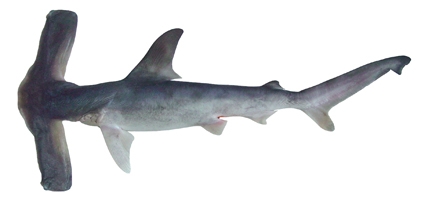Difference between revisions of "AY Honors/Species Account/Eusphyra blochii"
JadeDragon (talk | contribs) (Created page with "{{species id |common_name=Winghead shark |latin_name=Eusphyra blochii |image=Eusphyra blochii csiro-nfc.jpg |description=The winghead shark (Eusphyra blochii) is a species of ...") |
m (W126jep moved page Adventist Youth Honors Answer Book/Species Account/Eusphyra blochii to AY Honors/Species Account/Eusphyra blochii without leaving a redirect: Part of translatable page "Adventist Youth Honors Answer Book/Species Account/Eusphyra blochii") |
||
| (2 intermediate revisions by the same user not shown) | |||
| Line 1: | Line 1: | ||
| + | <noinclude><translate><!--T:1--> | ||
| + | </noinclude> | ||
{{species id | {{species id | ||
|common_name=Winghead shark | |common_name=Winghead shark | ||
| Line 5: | Line 7: | ||
|description=The winghead shark (Eusphyra blochii) is a species of hammerhead shark, family Sphyrnidae. Reaching a length of 1.9 m (6.2 ft), this small brown to gray shark has a slender body with a tall, sickle-shaped first dorsal fin. Its name comes from its incredibly large "hammer", or cephalofoil, which can be as wide as half of the shark's total length. The function of this structure is unclear but may relate to the shark's senses. The wide spacing of its eyes grant superb binocular vision, while the extremely long nostrils on the leading margin of the cephalofoil may allow for better detection and tracking of odor trails in the water. Harmless to humans, the winghead shark is caught throughout its range using gillnets, seines, stake nets, longlines, and hook-and-line. The meat is sold fresh, the fins are exported to Asia for shark fin soup, the liver is a source of vitamin oil, and the offal is processed into fishmeal | |description=The winghead shark (Eusphyra blochii) is a species of hammerhead shark, family Sphyrnidae. Reaching a length of 1.9 m (6.2 ft), this small brown to gray shark has a slender body with a tall, sickle-shaped first dorsal fin. Its name comes from its incredibly large "hammer", or cephalofoil, which can be as wide as half of the shark's total length. The function of this structure is unclear but may relate to the shark's senses. The wide spacing of its eyes grant superb binocular vision, while the extremely long nostrils on the leading margin of the cephalofoil may allow for better detection and tracking of odor trails in the water. Harmless to humans, the winghead shark is caught throughout its range using gillnets, seines, stake nets, longlines, and hook-and-line. The meat is sold fresh, the fins are exported to Asia for shark fin soup, the liver is a source of vitamin oil, and the offal is processed into fishmeal | ||
| + | <!--T:2--> | ||
|range= | |range= | ||
The winghead shark is found in the tropical western Indo-Pacific, from the Persian Gulf eastward across South and Southeast Asia to New Guinea and northern Queensland. Its range extends as far north as Taiwan and as far south as the Montebello Islands off Western Australia. This species inhabits shallow waters close to shore and has been known to enter estuaries | The winghead shark is found in the tropical western Indo-Pacific, from the Persian Gulf eastward across South and Southeast Asia to New Guinea and northern Queensland. Its range extends as far north as Taiwan and as far south as the Montebello Islands off Western Australia. This species inhabits shallow waters close to shore and has been known to enter estuaries | ||
}} | }} | ||
| + | <noinclude></translate></noinclude> | ||
Latest revision as of 23:12, 20 September 2021
Winghead shark (Eusphyra blochii)
Where found: The winghead shark is found in the tropical western Indo-Pacific, from the Persian Gulf eastward across South and Southeast Asia to New Guinea and northern Queensland. Its range extends as far north as Taiwan and as far south as the Montebello Islands off Western Australia. This species inhabits shallow waters close to shore and has been known to enter estuaries
Description: The winghead shark (Eusphyra blochii) is a species of hammerhead shark, family Sphyrnidae. Reaching a length of 1.9 m (6.2 ft), this small brown to gray shark has a slender body with a tall, sickle-shaped first dorsal fin. Its name comes from its incredibly large "hammer", or cephalofoil, which can be as wide as half of the shark's total length. The function of this structure is unclear but may relate to the shark's senses. The wide spacing of its eyes grant superb binocular vision, while the extremely long nostrils on the leading margin of the cephalofoil may allow for better detection and tracking of odor trails in the water. Harmless to humans, the winghead shark is caught throughout its range using gillnets, seines, stake nets, longlines, and hook-and-line. The meat is sold fresh, the fins are exported to Asia for shark fin soup, the liver is a source of vitamin oil, and the offal is processed into fishmeal

